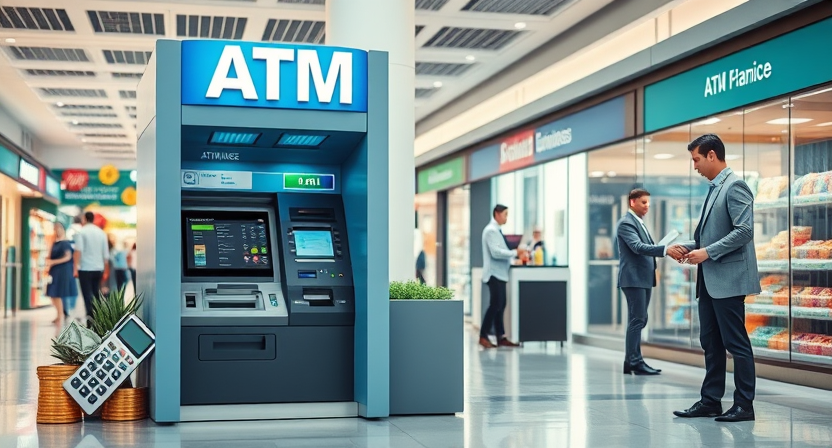How to Finance an ATM Business in 2025: A Complete Guide

How to Finance an ATM Business in 2025: A Complete Guide for Entrepreneurs
How to finance an ATM business in 2025, starting an ATM business can be a lucrative venture, offering passive income and long-term financial stability. However, like any business, it requires upfront capital to get started. If you’re wondering how to finance an ATM business, you’re in the right place. In this guide, we’ll explore the best financing options, tips for securing funds, and strategies to minimize costs.
How to Finance an ATM Business in 2025: Why Start an ATM Business?
Before diving into financing, let’s quickly discuss why an ATM business is worth considering:
- Passive Income: Once installed, ATMs generate revenue through transaction fees.
- Low Maintenance: ATMs require minimal upkeep compared to other businesses.
- High Demand: Cash is still king, and ATMs are essential for many businesses and consumers.
But how do you fund your ATM business? Let’s break it down.
1. Self-Financing: Use Your Savings
If you have personal savings, this is the simplest way to finance your ATM business. By self-funding, you avoid interest rates and loan approvals.
Pros:
- No debt or interest payments.
- Full control over your business.
Cons: - Ties up your personal funds.
- Limited to the amount you can afford to invest.

2. Small Business Loans
Small business loans are a popular option for financing an ATM business. Banks, credit unions, and online lenders offer loans specifically for entrepreneurs.
Tips for Securing a Loan:
- Prepare a solid business plan outlining your ATM business model, projected revenue, and expenses.
- Maintain a good credit score to qualify for lower interest rates.
- Consider SBA (Small Business Administration) loans, which often have favorable terms.
3. Equipment Financing
Since ATMs are the core of your business, equipment financing can be a smart choice. This type of loan is specifically for purchasing business equipment, such as ATM machines.
Pros:
- The ATM itself serves as collateral, reducing lender risk.
- Fixed monthly payments make budgeting easier.
Cons: - You don’t own the equipment until the loan is paid off.
4. Investors or Partnerships
If you’re looking for alternative financing, consider bringing in investors or partners. This could be a friend, family member, or business partner willing to invest in your ATM business in exchange for a share of the profits.
Pros:
- Access to additional funds without taking on debt.
- Partners can bring expertise and resources to the table.
Cons: - You’ll need to share profits and decision-making authority.
5. Crowdfunding
Crowdfunding platforms like Kickstarter or GoFundMe can help you raise funds for your ATM business. This option works best if you have a compelling story or unique angle to attract backers.
Tips for Success:
- Offer rewards or incentives for backers, such as a share of future profits.
- Create a compelling pitch video and detailed campaign description.
6. Lease ATM Machines
If purchasing ATMs outright is too expensive, consider leasing them. Many companies offer ATM leasing options, allowing you to spread the cost over time.
Pros:
- Lower upfront costs.
- Maintenance and repairs are often included in the lease.
Cons: - Higher long-term costs compared to buying.
- You don’t own the machines until the lease ends.
7. Creative Financing Options
If traditional financing isn’t an option, get creative! Here are some ideas:
- Vendor Financing: Some ATM suppliers offer financing options to help you purchase their machines.
- Credit Cards: Use a business credit card with a low-interest rate to cover initial costs.
- Grants: Research small business grants or programs that support entrepreneurs in your industry.
8. Minimize Costs to Maximize Profit
Financing your ATM business is only half the battle. To ensure success, keep your costs low:
- Negotiate Placement Fees: Partner with businesses that allow you to place ATMs on their premises for free or at a low cost.
- Buy Used ATMs: Purchasing refurbished ATMs can save you thousands of dollars.
- Focus on High-Traffic Locations: Choose locations with high foot traffic to maximize transaction fees.
Frequently Asked Questions (FAQs)
1. How much does it cost to start an ATM business?
The cost to start an ATM business typically ranges from 2,000to10,000 per machine, depending on whether you buy new or used ATMs and the associated installation and operational costs.
2. Can I start an ATM business with no money?
While it’s challenging, you can start an ATM business with no money by partnering with investors, leasing equipment, or using creative financing options like vendor financing.
3. How profitable is an ATM business?
An ATM business can generate 200to500 per month per machine in transaction fees, depending on location and usage. With multiple machines, this can add up to a significant passive income stream.
4. What are the risks of starting an ATM business?
The main risks include theft, vandalism, and fluctuating cash usage due to digital payment trends. However, proper location selection and insurance can mitigate these risks.
Final Thoughts
Financing an ATM business doesn’t have to be overwhelming. By exploring options like small business loans, equipment financing, or creative funding strategies, you can secure the capital you need to get started. Remember, the key to success is careful planning, minimizing costs, and choosing high-traffic locations for your ATMs.




